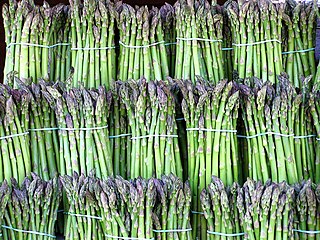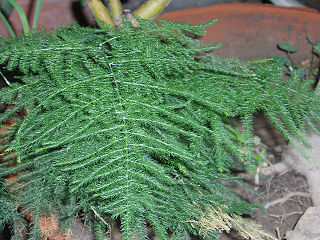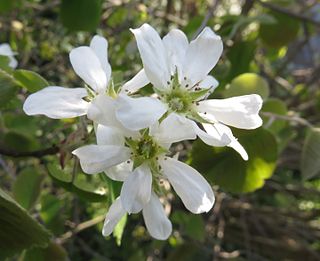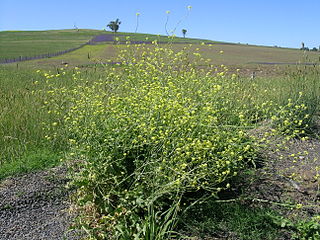
Asparagus, or garden asparagus, folk name sparrow grass, scientific name Asparagus officinalis, is a perennial flowering plant species in the genus Asparagus. Its young shoots are used as a spring vegetable.

Asparagus is a genus of flowering plants in the family Asparagaceae, subfamily Asparagoideae. It comprises up to 300 species. Most are evergreen long-lived perennial plants growing from the understory as lianas, bushes or climbing plants. The best-known species is the edible Asparagus officinalis, commonly referred to as just asparagus. Some other members of the genus, such as Asparagus densiflorus, are grown as ornamental plants.

Salicornia is a genus of succulent, halophyte flowering plants in the family Amaranthaceae that grow in salt marshes, on beaches, and among mangroves. Salicornia species are native to North America, Europe, South Africa, and South Asia. Common names for the genus include glasswort, pickleweed, picklegrass, and marsh samphire; these common names are also used for some species not in Salicornia. To French speakers in Atlantic Canada, they are known, colloquially, as "titines de souris". The main European species is often eaten, called marsh samphire in Britain, and the main North American species is occasionally sold in grocery stores or appears on restaurant menus, usually as 'sea beans' or samphire greens or sea asparagus.

Abutilon theophrasti is an annual plant in the family Malvaceae, native to southern Asia. Its specific epithet theophrasti commemorates the ancient Greek botanist-philosopher Theophrastus. Abutilon theophrasti is the type species of the genus Abutilon.

Quercus coccifera, the kermes oak, is an oak tree in the Quercus section Cerris. It is native to the Mediterranean region and Northern African Maghreb, south to north from Morocco to France and west to east from Portugal to Cyprus and Turkey, crossing Spain, Italy, Libya, Balkans, and Greece, including Crete. The Kermes Oak was historically important as the food plant of the Kermes scale insect, from which a red dye called crimson was obtained. The etymology of the specific name coccifera is related to the production of red cochineal (crimson) dye and derived from Latin coccum which was from Greek κόκκος, the kermes insect. The Latin -fera means 'bearer'.

Halimione portulacoides or sea purslane (2n=36) is a small greyish-green shrub widely distributed in temperate Eurasia and parts of Africa.
Plants For A Future (PFAF) is an online not for profit resource for those interested in edible and useful plants, with a focus on temperate regions. The organization's emphasis is on perennial plants.

Amelanchier interior or Wiegand's shadbush is type of serviceberry shrub. It produces a sweet tasting edible fruit called a pome, which can be eaten raw or cooked. The fruit has a sweet flavor. This species is a deciduous tree. It grows on hillsides and banks of streams and reaches up to nine meters. The plant prefers light (sandy), medium (loamy) and heavy (clay) soils and can grow in heavy clay soil. It can grow it acid, neutral and alkaline soils, as well as shade or semi-shade. It requires moist soil.

Hirschfeldia incana is a species of flowering plant in the mustard family known by many common names, including shortpod mustard, buchanweed, hoary mustard and Mediterranean mustard. It is the only species in the monotypic genus Hirschfeldia, which is closely related to Brassica. The species is native to the Mediterranean Basin but it can be found in many parts of the world as an introduced species and often a very abundant noxious weed. This mustard is very similar in appearance to black mustard, but is generally shorter. It forms a wide basal rosette of lobed leaves which lie flat on the ground, and it keeps its leaves while flowering. Its stem and foliage have soft white hairs. Unlike black mustard, H. incana is a perennial plant.

Otanthus is a genus of flowering plants in the chamomile tribe (Anthemideae) within the daisy family. The only known species is the cotton weed plant, Otanthus maritimus. It is a small pioneering perennial that grows in the dune areas throughout the Mediterranean and exerts a stabilizing action on the sandy soils. A thick white down covers both the stems and the small oval, slightly saw-toothed alternate leaves. The globose flower heads, with their short peduncles, are composed of an envelope of white-wooly scales around tubular yellow flowers that are visible from June through to September. The generic name is derived from the Greek words otos (ear) and anthos (flower). This refers to the form of the corolla, which is composed of three membranous bracts that create a profile similar to that of a human ear.

Gymnopilus maritimus is a fungus species of the family Cortinariaceae first collected in northern Sardinia, Italy, in 2006. The species produces moderately sized, sturdy mushrooms of a reddish-orange colour. The cap, which can measure up to 70 millimetres (3 in) across, is covered in orange fibrils, and sometimes has small scales. The yellowish stem measures up to 110 mm (4 in) in length by 8 mm (0.3 in) in width, and sometimes shows remnants of the partial veil. The mushrooms have thick gills of a variable colour, ranging from yellow to rust but staining darker, and the yellow flesh has a mild taste. The mushrooms leave a rusty-brown spore print, while the spores themselves measure from 7.5–11.5 micrometres (0.00030–0.00045 in) in length. The species is most similar in appearance to G. arenophilus and G. fulgens, but can be differentiated from both morphologically. Despite the similarities, it is not closely related to either, suggesting convergent evolution. Instead, within the genus Gymnopilus, it is most closely related to the spectabilis–imperialis clade. However, it is not particularly similar to any of its closest relatives.

Asparagus acutifolius, common name wild asparagus, is an evergreen perennial plant belonging to the genus Asparagus. The specific epithet, acutifolius, meaning "thorny leaves", is derived from Latin acutus, and -folius (-leaved), and refers to the characteristic shape of the leaves, a quite common feature in the typical plants of the Mediterranean.

Tetragonolobus purpureus, synonym Lotus tetragonolobus, known as asparagus-pea or winged pea, is an annual leguminous herb native to the countries around the Mediterranean, although introduced elsewhere. It is low growing, and produces a profusion of prominent deep red flowers, followed by seed pods that are longitudinally winged.
Amaranthus mitchellii is commonly known as Mitchell's amaranth or boggabri weed. It is from the family Amaranthaceae. It is a generally useful plant and is said to be "edible".

Medeola virginiana, known as Indian cucumber or Indian cucumber-root, is an eastern North American plant species in the lily family, Liliaceae. It is the only currently recognized plant species in the genus Medeola. It grows in the understory of forests. The plant bears edible rhizomes that have a mild cucumber-like flavor.

Pulsatilla cernua, the narrow-leaf pasque-flower is a species of plant in the family Ranunculaceae Pulsatilla cernua is a perennial plant that can grow to be about 0.2 m or 8 in tall. This plant has six dark red/purple flowers and has tiny white, silky villose hairs. Pulsatilla cernua flowers from April to May, and then the seeds ripen from May to June. P. cernua is insect pollinated. This plant has both male and female parts, which means it is a hermaphrodite. Most parts of this plant are not edible, except for the roots and leaves.
Abutilon × milleri, also known as Miller abutilon, is a hybrid species, the result of cross of A. megapotamicum and possibly A. pictum, in the family Malvaceae. It is an evergreen species of flowering plant. It has gained the Royal Horticultural Society's Award of Garden Merit as an ornamental.
Lasjia hildebrandii, also known as Celebes nut, Sulawesi nut, Sulawesi macadamia or Hildebrand's macadamia, is a species of forest tree in the protea family that is endemic to the island of Sulawesi, Indonesia. Its closest relative is Lasjia erecta, also a Sulawesi endemic.
Vaccinium formosum, with common names highbush blueberry, southern blueberry, southern highbush blueberry, and swamp highbush blueberry, is a species of blueberry that is native to the Southeastern United States.














